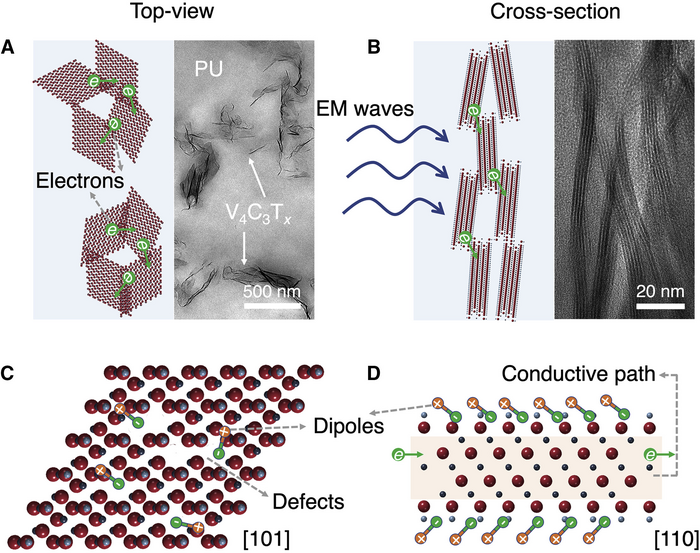The advent of two-dimensional nanomaterials with modifiable surface properties, such as MXenes, has recently transformed the field of electromagnetic interference (EMI) shielding.

Schematics and TEM images of vacuum-filtered vadanium-based MXene polyurethane composite. Image Credit: Drexel University
However, the strong electrical conductance and moderate dielectric loss of traditional titanium-based MXenes result in considerable reflection of electromagnetic waves, leading to minimal microwave absorption.
A recent study published in Cell Reports Physical Science tackles this problem by utilizing the remarkable microwave absorption ability of novel vanadium-based MXenes.
Electromagnetic Interference Shielding
Electromagnetic interference (EMI) shielding refers to fabrication processes and substances to prevent external electromagnetic signals from disrupting communications.
Electromagnetic interference (EMI) can interfere with electronic devices, machinery, and networks used in mission-critical applications such as military-grade avionics, commercial touch screens, and mass transportation systems. Both artificial and natural sources can cause electromagnetic interference, and its effects may vary from transient interruptions and data loss to mechanical malfunction and even fatal accidents.
With the ever-increasing integration complexity and functionalities of modern technologies, electromagnetic interference (EMI) shielding has proven indispensable for protecting electronics from catastrophic signal blockage. Traditional EMI shielding is achieved using materials that reflect the majority of incident electromagnetic (EM) radiations.
Unfortunately, these reflected radiations are still capable of causing secondary EM pollution, which is detrimental to device-to-device interactions. Therefore, the optimal EMI shielding substance should absorb rather than reflect undesirable EM radiation.
MXenes for Electromagnetic Interference Shielding
MXenes are a family of two-dimensional inorganic materials composed of a few layers of transition metallic carbides, nitrides, or carbonitrides. MXenes are important two-dimensional compounds because they combine the metallic conductance of transition metals with a remarkable hydrophilic character.
MXenes have demonstrated record-breaking EMI shielding abilities in thin coatings due to their strong metallic conductance. For instance, a 40 nanometer-thick MXene coating can provide an EMI shielding efficiency (SE) of 21 dB, exceeding the industrial shielding standards.
While EMI shielding involves effects from both absorption and reflection, reflection continues to dominate the shielding performance of all pure MXenes. This phenomenon is due to the impedance mismatch of pure MXenes, hindering the material's high electrical conductance and effective microwave absorption.
Microwave absorption materials, which are composites of MXenes with substances such as magnetic nanoparticles, carbon compounds, and semiconductors, provide an alternate strategy for EMI shielding applications. These materials can absorb incoming electromagnetic waves and convert microwave energy into thermal energy.
Limitations of Conventional Titanium-based MXenes
Several titanium-based MXene composites have been developed in the last five years to address the impedance mismatch and EM wave suppression of pure MXenes. However, these composites exhibit considerably large transmittance and low dielectric loss in the gigahertz region, whereas optimal EM wave absorption substances need both moderate transmittance and large tangential loss.
As a result, composites of titanium-based MXenes are unlikely to produce effective microwave absorption across a wide range of frequencies. Many research groups have lately concentrated on introducing additional EM-absorbing materials to titanium-based MXenes, such as reduced graphene oxide, to extend the absorption spectrum for radar stealth and EMI shielding applications.
However, the benefits of titanium-based MXenes are greatly diminished because of the greater filler content and complex interface architecture. As a result, producing lightweight, wideband, and economical MXene-based microwave absorbers remains difficult.
Aside from titanium-based MXenes, approximately 30 stoichiometric MXenes have been produced experimentally for electromagnetic interference applications. However, their dielectric characteristics, crucial for boosting electromagnetic absorption, are poorly understood.
Highlights and Key Developments of the Current Study
The researchers developed unique vanadium-based MXenes for EMI shielding applications in this study. The study's main goal was to look into microwave absorption, fundamental dielectric properties, and EMI shielding capacity of vanadium-based MXenes.
The as-prepared MXenes were combined with polyurethane (PU) composites in various ratios to comprehend the relationship of vanadium-based MXenes with microwaves. Finally, the electrical characteristics of the as-prepared MXenes were determined theoretically and experimentally.
Vanadium-based MXenes in a polyurethane (PU) matrix demonstrated ultra-effective microwave absorption (>90% of EM waves absorbed) over the entire X band (8.2–12.4 GHz). As a result, the as-prepared vanadium-based MXenes readily outperformed traditional titanium-based MXenes as microwave absorption materials.
The low dielectric loss of vanadium-based MXenes, together with their changeable surface properties, two-dimensional nature, and high carrier mobility, suggests a new horizon for the creation of thin and highly absorbing MXene-based electromagnetic shielding materials.
Reference
Han, M. et al. (2022). Efficient microwave absorption with Vn+1CnTx MXenes. Cell Reports Physical Science. Available at: https://doi.org/10.1016/j.xcrp.2022.101073
Disclaimer: The views expressed here are those of the author expressed in their private capacity and do not necessarily represent the views of AZoM.com Limited T/A AZoNetwork the owner and operator of this website. This disclaimer forms part of the Terms and conditions of use of this website.